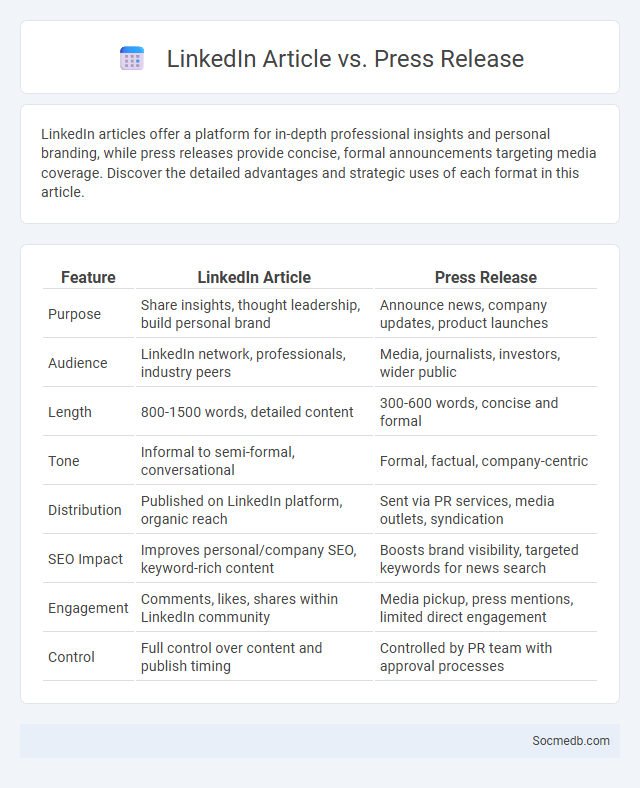
Photo illustration: LinkedIn Article vs Press Release
LinkedIn articles offer a platform for in-depth professional insights and personal branding, while press releases provide concise, formal announcements targeting media coverage. Discover the detailed advantages and strategic uses of each format in this article.
Table of Comparison
| Feature | LinkedIn Article | Press Release |
|---|---|---|
| Purpose | Share insights, thought leadership, build personal brand | Announce news, company updates, product launches |
| Audience | LinkedIn network, professionals, industry peers | Media, journalists, investors, wider public |
| Length | 800-1500 words, detailed content | 300-600 words, concise and formal |
| Tone | Informal to semi-formal, conversational | Formal, factual, company-centric |
| Distribution | Published on LinkedIn platform, organic reach | Sent via PR services, media outlets, syndication |
| SEO Impact | Improves personal/company SEO, keyword-rich content | Boosts brand visibility, targeted keywords for news search |
| Engagement | Comments, likes, shares within LinkedIn community | Media pickup, press mentions, limited direct engagement |
| Control | Full control over content and publish timing | Controlled by PR team with approval processes |
Understanding LinkedIn Articles
LinkedIn Articles enable You to share in-depth professional insights that enhance your personal brand and industry expertise. Crafting well-structured, keyword-rich content improves visibility in LinkedIn's search algorithm, attracting targeted connections and potential clients. Consistent publishing establishes authority, driving engagement and fostering meaningful networking opportunities within Your professional community.
What is a Press Release?
A press release is an official statement issued to media outlets to announce newsworthy events, product launches, or company updates. It typically includes key information such as the who, what, when, where, and why to capture journalists' attention and generate coverage. Effective press releases enhance brand visibility and drive engagement on social media platforms.
Defining Traditional Articles
Traditional articles on social media are structured pieces of content designed to inform, educate, or entertain your audience with clear headings, subheadings, and well-researched information. These articles typically feature a formal tone, longer length, and in-depth analysis compared to ephemeral posts or tweets, catering to readers seeking comprehensive insights. Mastering the creation of traditional articles helps you establish authority and build trust within your social media community.
Key Objectives of Each Format
Social media formats each serve distinct purposes tailored to specific goals: Instagram excels at visual storytelling to enhance brand awareness and engagement; Twitter drives real-time conversations and customer service through concise updates; LinkedIn targets professional networking and B2B marketing by showcasing expertise and company culture. Knowing these key objectives helps you optimize content strategy for maximum impact and audience connection. Effective use of each platform's strengths ensures your brand message resonates clearly with your target market.
Audience Targeting Differences
Social media platforms offer varied audience targeting options, with Facebook excelling in detailed demographic and interest-based targeting, while LinkedIn focuses on professional attributes like job title and industry. Instagram leverages visual engagement data for influencer and lifestyle targeting, contrasting with Twitter's emphasis on real-time interests and conversation topics. Understanding these differences allows marketers to tailor campaigns effectively, optimizing reach and engagement across diverse user behaviors and platform algorithms.
Content Structure and Style Comparison
Content structure on social media varies by platform, with Instagram emphasizing visually-driven, concise captions while Twitter prioritizes brief, impactful text limited by character count. Style on LinkedIn tends to be professional and detail-oriented, encouraging thorough narratives and expert insights, whereas TikTok favors casual, dynamic, and often entertaining video snippets that engage viewers quickly. Understanding these stylistic and structural differences helps you tailor your content effectively, maximizing reach and audience engagement across diverse social media channels.
Distribution Channels Explained
Social media platforms function as powerful distribution channels by enabling businesses to share content directly with target audiences across multiple networks like Facebook, Instagram, Twitter, and LinkedIn. These channels optimize reach through algorithms that prioritize engagement, helping your message spread organically or through paid promotions. Effective use of social media distribution channels increases brand visibility, drives traffic, and improves customer interaction.
SEO and Visibility Considerations
Effective social media strategies enhance your website's SEO by driving organic traffic and increasing brand visibility across platforms like Facebook, Instagram, and LinkedIn. Optimizing social media profiles with relevant keywords and regularly sharing high-quality, shareable content signals authority to search engines, improving your search rankings. Leveraging social media analytics helps you tailor content that resonates with your audience, boosting engagement and maximizing your online visibility.
Measuring Success and Impact
Measuring success and impact on social media relies heavily on key performance indicators (KPIs) such as engagement rate, reach, impressions, and conversion metrics. Analyzing data from platforms like Facebook Insights, Instagram Analytics, and Twitter Analytics provides actionable insights into audience behavior and content effectiveness. Tracking return on investment (ROI) through tools like Google Analytics helps quantify the impact of social media campaigns on business objectives.
Choosing the Right Format for Your Message
Choosing the right format for your social media message enhances engagement and ensures your content resonates with your audience. Visuals like images or videos often boost visibility and interaction, while concise text appeals to followers seeking quick updates. Tailoring your format to the platform and your audience's preferences maximizes the impact of your message.
 socmedb.com
socmedb.com